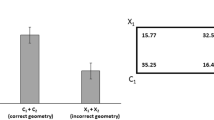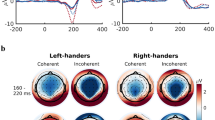Abstract
The human brain activities of steady-state visual evoked potentials, induced by a virtual panorama and two objects, were recorded for two subjects in immersive virtual environment. The linear discriminant analysis with single trial EEG data for 1.0 seconds resulted in 74.2 % of averaged recognition rate in inferring three gaze directions. The possibility of online interaction with 3D images in CAVE will be addressed for walking application or remote control of a robotic camera.
Chapter PDF
Similar content being viewed by others
Keywords
These keywords were added by machine and not by the authors. This process is experimental and the keywords may be updated as the learning algorithm improves.
References
Wolpaw, J.R., et al.: Brain-computer interfaces for communication and control. Clinical Neurophysiology 113, 767–791 (2002)
Pfurtscheller, G., et al.: Walking from thought. Brain Research 1071, 145–152 (2006)
Kuroiwa, Y., et al.: Visual Evoked Potentials with hemifield pattern stimulation, Their use in the diagnosis of retrochiasmatic lesions. Arch. Neurol. 38, 86–90 (1981)
Trejo, L.J., et al.: Brain-computer interfaces for 1-D and 2-D cursor control: designs using volitional control of the EEG spectrum or steady-state visual evoked potentials. IEEE trans neural Syst. Rehabil. Eng. 14(2), 225–229 (2006)
Middendorf, M., et al.: Brain-Computer Interfaces Based on the Steady-State Visual-Evoked Response. IEEE Transactions on Rehabilitation Engineering 8(2), 211–214 (2000)
Cheng, M., et al.: Design and Implementation of a Brain-Computer Interface With High Transfer Rates. IEEE Transactions on Biomedical Engineering 49(10), 1181–1186 (2002)
Touyama, H. et al.: Brain computer interface via stereoscopic images in CAVE. In: 12th International Conference on Human-Computer Interaction (HCI International (to appear, 2007)
Cruz-Neira, C. et al.: Surround-screen projection-based virtual reality: The design and implementation of the CAVE. In: ACM SIGGRAPH 1993, Proc. pp. 135–142(1993)
Author information
Authors and Affiliations
Editor information
Rights and permissions
Copyright information
© 2007 Springer-Verlag Berlin Heidelberg
About this paper
Cite this paper
Touyama, H., Hirose, M. (2007). Steady-State VEPs in CAVE for Walking Around the Virtual World. In: Stephanidis, C. (eds) Universal Access in Human-Computer Interaction. Ambient Interaction. UAHCI 2007. Lecture Notes in Computer Science, vol 4555. Springer, Berlin, Heidelberg. https://doi.org/10.1007/978-3-540-73281-5_78
Download citation
DOI: https://doi.org/10.1007/978-3-540-73281-5_78
Publisher Name: Springer, Berlin, Heidelberg
Print ISBN: 978-3-540-73280-8
Online ISBN: 978-3-540-73281-5
eBook Packages: Computer ScienceComputer Science (R0)




